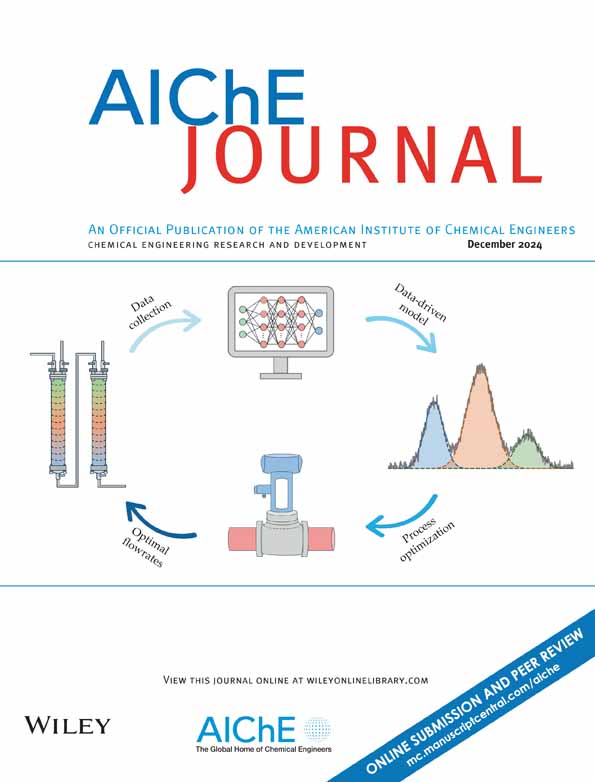促进木质素衍生碳负载MnO-Ni在甘油转化为二羟基丙酮过程中的中间羟基吸附
IF 4
3区 工程技术
Q2 ENGINEERING, CHEMICAL
引用次数: 0
摘要
在温和条件下电化学将甘油转化为二羟基丙酮(DHA),有效地解决了甘油过剩问题,提高了其经济价值。然而,在弱碱性条件下,DHA的生产效率仍然受到二级羟基的位阻和甘油电氧化反应(GOR)动力学迟缓的限制。本文通过自组装沉淀和原位热解合成了木质素衍生的碳负载MnO-Ni异质结催化剂(MnO-Ni /C)。优化后的MnO-Ni /C催化剂需要1.58 V的低电位才能达到10 mA cm−2,比析氧反应(OER)低270 mV。在1.8 V下,DHA的选择性为53.37%,产率为864.75 mmol m−2 h−1。MnO-Ni /C异质结构调节了Ni位点的局部电子结构,优化了甘油吸附构型,增强了电极表面附近仲羟基和氧活性物质的选择性吸附。这些协同效应显著提高了GOR动力学和DHA生产效率。本文章由计算机程序翻译,如有差异,请以英文原文为准。
Boosting middle hydroxyl adsorption on lignin‐derived carbon loaded MnO–Ni for glycerol conversion to dihydroxyacetone
The electrochemical conversion of glycerol into dihydroxyacetone (DHA) under mild conditions efficiently addresses glycerol surplus, enhancing its economic value. However, DHA production efficiency remains constrained by steric hindrance from secondary hydroxyl groups and sluggish glycerol electro‐oxidation reaction (GOR) kinetics in weakly alkaline conditions. Herein, lignin‐derived carbon‐supported MnO–Ni heterojunction catalyst (MnO–Ni/C) is synthesized via self‐assembly precipitation and in situ pyrolysis. The optimized MnO–Ni/C catalyst requires a low potential of 1.58 V to achieve 10 mA cm−2 , 270 mV lower than the oxygen evolution reaction (OER). It attains a 53.37% DHA selectivity with a high production rate of 864.75 mmol m−2 h−1 at 1.8 V. MnO–Ni/C heterostructures modulate the local electronic structure of Ni sites, optimizing glycerol adsorption configuration and enhancing selective adsorption of secondary hydroxyl groups and oxygen active species near the electrode surface. These synergistic effects significantly improve GOR kinetics and DHA production efficiency.
求助全文
通过发布文献求助,成功后即可免费获取论文全文。
去求助
来源期刊

AIChE Journal
工程技术-工程:化工
CiteScore
7.10
自引率
10.80%
发文量
411
审稿时长
3.6 months
期刊介绍:
The AIChE Journal is the premier research monthly in chemical engineering and related fields. This peer-reviewed and broad-based journal reports on the most important and latest technological advances in core areas of chemical engineering as well as in other relevant engineering disciplines. To keep abreast with the progressive outlook of the profession, the Journal has been expanding the scope of its editorial contents to include such fast developing areas as biotechnology, electrochemical engineering, and environmental engineering.
The AIChE Journal is indeed the global communications vehicle for the world-renowned researchers to exchange top-notch research findings with one another. Subscribing to the AIChE Journal is like having immediate access to nine topical journals in the field.
Articles are categorized according to the following topical areas:
Biomolecular Engineering, Bioengineering, Biochemicals, Biofuels, and Food
Inorganic Materials: Synthesis and Processing
Particle Technology and Fluidization
Process Systems Engineering
Reaction Engineering, Kinetics and Catalysis
Separations: Materials, Devices and Processes
Soft Materials: Synthesis, Processing and Products
Thermodynamics and Molecular-Scale Phenomena
Transport Phenomena and Fluid Mechanics.
 求助内容:
求助内容: 应助结果提醒方式:
应助结果提醒方式:


